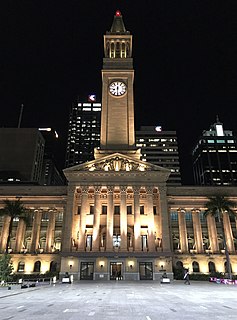
Brisbane City Hall, in Brisbane, Queensland, Australia, is the seat of the Brisbane City Council. It is located adjacent to King George Square, where the rectangular City Hall has its main entrance. The City Hall also has frontages and entrances in both Ann Street and Adelaide Street. The building design is based on a combination of the Roman Pantheon, and St Mark's Campanile in Venice and is considered one of Brisbane's finest buildings. It was listed on the Register of the National Estate in 1978 and on the Queensland Heritage Register in 1992. It is also iconic for its Westminster chimes which sound on the quarter-hour.
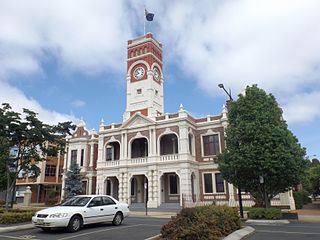
Toowoomba City Hall is a heritage-listed town hall at 541 Ruthven Street, Toowoomba, Toowoomba Region, Queensland, Australia. It was designed by Willoughby Powell and built in 1900 by Alexander Mayne. It is also known as Toowoomba Town Hall. It was added to the Queensland Heritage Register on 21 October 1992.

The Old South Brisbane Town Hall is the heritage-listed town hall of the Borough of South Brisbane, later the City of South Brisbane, Queensland, Australia. It is located at 263 Vulture Street, South Brisbane, adjacent to Cumbooquepa, the residence of William Stephens, the Member of the Legislative Assembly of Queensland and mayor of Borough of South Brisbane.
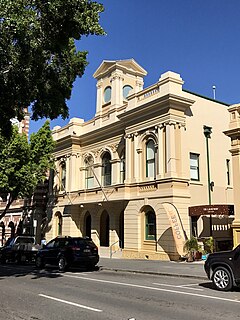
Old Ipswich Town Hall is a heritage-listed former town hall at 116 Brisbane Street, Ipswich, City of Ipswich, Queensland, Australia. It was designed by James Percy Owen Cowlishaw and built from 1861 to 1879. It is also known as Mechanics School of Arts and the School of Arts. It was added to the Queensland Heritage Register on 21 October 1992.
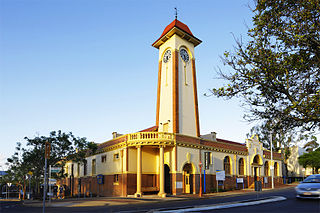
Sandgate Town Hall is a heritage-listed town hall at 5 Brighton Road, Sandgate, City of Brisbane, Queensland, Australia. It was designed by Thomas Ramsay Hall and built from 1911 to 1912 by John Gemmell. It was added to the Queensland Heritage Register on 13 January 1995.

Mackay Town Hall is a heritage-listed former town hall at 63 Sydney Street, Mackay, Mackay Region, Queensland, Australia. It is the second town hall to be built on this site. It was designed by Arthur Rigby built in 1912 by Charles Porter for the Mackay Town Council. It was added to the Queensland Heritage Register on 29 May 1998.

West End State School is a heritage-listed state school at 24 Vulture Street, West End, City of Brisbane, Queensland, Australia. It was built from 1891 to 1960. It was added to the Queensland Heritage Register on 24 April 2018.

Toowoomba Post Office is a heritage-listed former post office at 136 Margaret Street, Toowoomba City, Toowoomba, Toowoomba Region, Queensland, Australia. It was designed by Francis Drummond Greville Stanley and built from 1878 to 1908 by John Gargett. It was added to the Queensland Heritage Register on 24 January 2003.

South Brisbane Library is a heritage-listed former library at 472 Stanley Street, South Brisbane, City of Brisbane, Queensland, Australia. It was designed by Francis Drummond Greville Stanley and built from 1881 to 1902 by W Macfarlane. It is also known as South Brisbane School of Arts, South Brisbane Mechanics Institute, South Brisbane Technical College, and South Brisbane Post & Telegraph Office. It was added to the Queensland Heritage Register on 21 October 1992. It now houses the Griffith University Film School, which forms part of the Queensland College of Art.

Brisbane School of Arts is a heritage-listed school of arts at 166 Ann Street, Brisbane City, City of Brisbane, Queensland, Australia. It was built from 1865 to 1985. It is also known as former Servants Home. It was added to the Queensland Heritage Register on 21 October 1992.
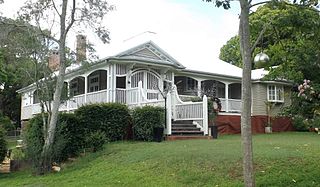
Weemalla is a heritage-listed detached house at 62 Ruthven Street, Corinda, City of Brisbane, Queensland, Australia. It was designed by Robin Dods and built from 1908 to 1909 by Hall and Mayer. It is also known as Steele House. It was added to the Queensland Heritage Register on 9 August 2013.

Our Lady of Assumption Convent is a heritage-listed former Roman Catholic convent at 8 Locke Street, Warwick, Southern Downs Region, Queensland, Australia. It was designed by Simkin & Ibler and built from 1891 to 1914. It is also known as Assumption College, Cloisters, and Sophia College. It was added to the Queensland Heritage Register on 21 October 1992.

Warwick Town Hall is a heritage-listed town hall at 72 Palmerin Street, Warwick, Southern Downs Region, Queensland, Australia. It was built from 1887 to 1917. It is also known as Footballers Memorial. It was added to the Queensland Heritage Register on 21 October 1992.
Maryborough City Hall is a heritage-listed town hall at 388 Kent Street, Maryborough, Fraser Coast Region, Queensland, Australia. It was designed by Hall & Dods and built from 1906 to 1908 by Crystall & Armstrong. It is also known as Maryborough Town Hall. It was added to the Queensland Heritage Register on 21 October 1992.

Maryborough School of Arts is a heritage-listed School of Arts building at 427 Kent Street, Maryborough, Fraser Coast Region, Queensland, Australia. It was designed by John Harry Grainger and built from 1887 to 1888 by Jacob & John Rooney. It is also known as Museum and Technical College and Recreation Club. It was added to the Queensland Heritage Register on 21 October 1992.

Townsville School of Arts is a heritage-listed former school of arts and now community cultural centre at Stanley Street, Townsville CBD, City of Townsville, Queensland, Australia. It was designed by Eyre & Munro and built in 1891 by James Smith. It is also known as Dancenorth Theatre and Townsville Arts Centre. It was added to the Queensland Heritage Register on 21 October 1992.

Barcaldine Shire Hall is a heritage-listed town hall at Ash Street, Barcaldine, Queensland, Australia. It was designed by Alfred Mowbray Hutton and built from 1911 to 1912 by Robinson & Freeman. It was added to the Queensland Heritage Register on 29 April 2003.

Bundaberg Post Office is a heritage-listed post office at 155a Bourbong Street, Bundaberg Central, Bundaberg, Bundaberg Region, Queensland, Australia. It was added to the Australian Commonwealth Heritage List on 8 November 2011.

Charters Towers Post Office is a heritage-listed post office at 17 Gill Street, Charters Towers City, Charters Towers, Charters Towers Region, Queensland, Australia. It was added to the Australian Commonwealth Heritage List on 8 November 2011.

Stanthorpe Post Office is a heritage-listed post office at 14 Maryland Street, Stanthorpe, Southern Downs Region, Queensland, Australia. It was designed by John Smith Murdoch of the Queensland Government Architect's office and was built by D. Stewart and Co in 1901. It was added to the Australian Commonwealth Heritage List on 22 June 2004.






















